ECU CHEVROLET CAMARO 1967 1.G Chassis Manual PDF
[x] Cancel search | Manufacturer: CHEVROLET, Model Year: 1967, Model line: CAMARO, Model: CHEVROLET CAMARO 1967 1.GPages: 659, PDF Size: 114.24 MB
Page 415 of 659

FUEL TANK AND EXHAUST SYSTEMS 8-9
SEDAN
STATION WAGON AND PICKUP
Fig.
8—Fuel Tanks
FUEL TANK VENT LINE
Sedan model fuel tanks are vented to the atmosphere
at the top right forward edge of the tank. The vent line
is connected by a rubber hose with two clamps one at the
tank and the other at the vent pipe which is secured to the
underbody as shown in Figure 8. A rubber grommet
around the vent pipe acts as a seal to prevent gasoline
fumes from entering the passenger compartment.
IMPORTANT: It is important to note that the
gas tank is not vented at the cap; therefore, it
is necessary to be assured that the vent line is
free from dirt, etc., and that the gas tank vent
line is open at all times. If gasoline fumes are
detected, the rubber grommet should be checked.
Station wagon and pickup model tanks are vented from
the tank to the filler neck (fig. 9) and use a vented cap.
The vent outlet pipe on the tank is connected to the vent
inlet pipe on the filler neck by a rubber hose. The hose
is secured with two wire clamps.
Fig.
9—Filler Neck and Vent Assemblies
Fig.
10—Installing Fuel Line Retainer Clip
CHEVROLET CHASSIS SERVICE MANUAL
Page 417 of 659

FUEL TANK AND EXHAUST SYSTEMS 8-11
EXHAUST SYSTEMS
INDEX
Page
General Description 8-11
Component Part Replacement 8-12
Muffler Assembly 8-12
Exhaust Pipes. 8-12
Tail Pipes 8-12
GENERAL DESCRIPTION
V-8
VIEW C
VIEW D
(EXCEPT WAGON)
L-6
VIEW A
Fig.
13—Single Exhaust System
The single exhaust system used on all six cylinder
engine models consists of an exhaust pipe, muffler and
tail pipe (fig. 13), An exhaust crossover pipe is added on
V-8 engine single exhaust models to connect the exhaust
manifolds to the system. A dual exhaust system, availa-
ble on V-8 engine models includes two exhaust pipes,
mufflers, and tail pipes and attaching hardware (fig. 14).
All systems are suspended on brackets with insulators
for rattle free operation.
The mufflers are a seam rolled construction with spot
welded baffles, with a capacity for muffling the exhaust
and at the same time, minimizing back pressure for
maximum engine efficiency. The internal parts of the
muffler are spot welded in position while external parts
are electric arc-welded to eliminate a chance of pre-
mature failure or rattle.
The exhaust system center mounting at the muffler lo-
cation (fig. 13) consists of an underbody bracket, an insu-
lator and a clamp. The clamp holds the muffler and tail
pipe with a "U" bolt and at the same time secures the
muffler and pipe to the body.
The exhaust system mounting at the end of the tail pipe
secures the pipe to a bracket assembly and insulator at-
tached to an existing underbody bracket (fig. 13).
CHEVROLET CHASSIS SERVICE MANUAL
Page 418 of 659
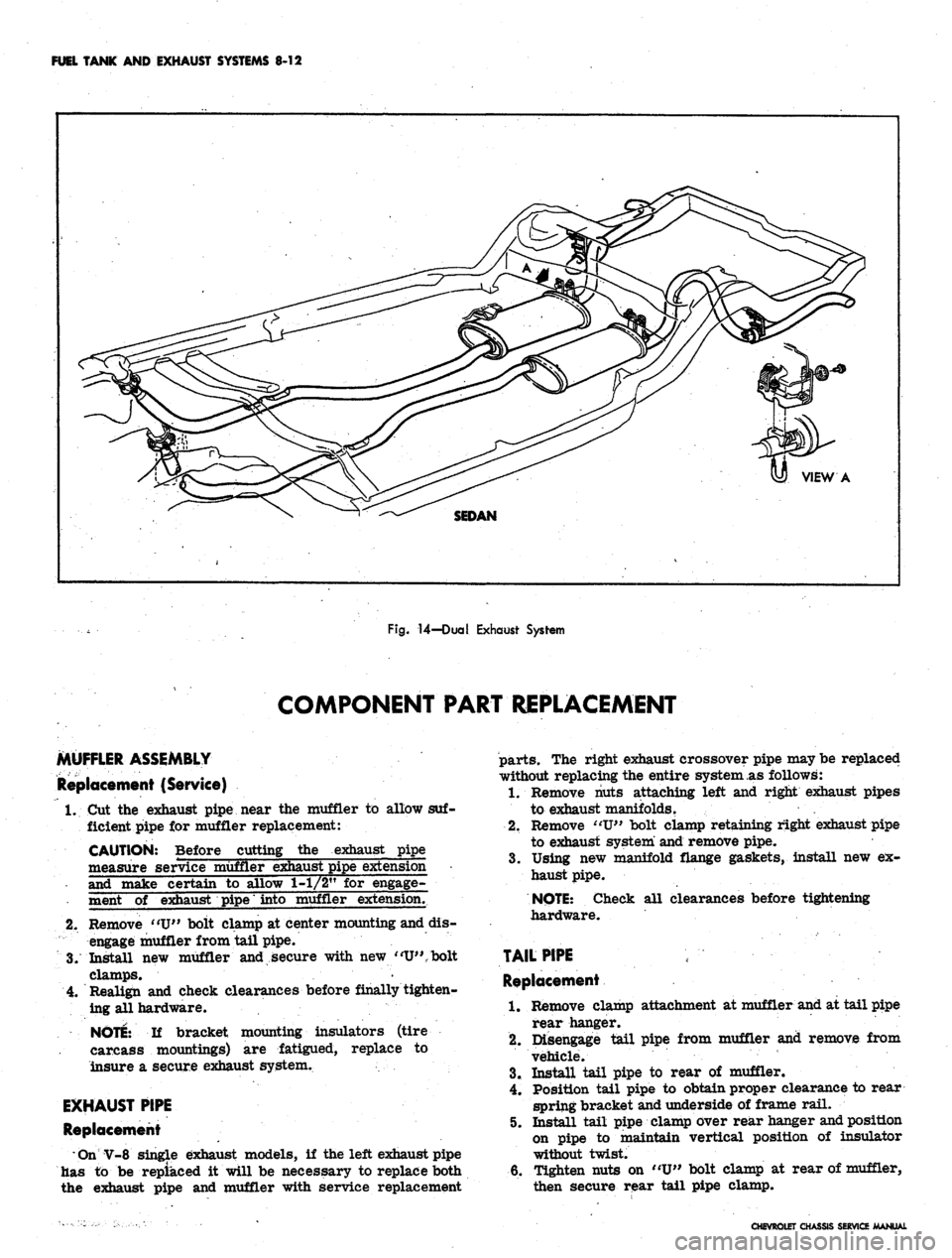
FUEL TANK AND EXHAUST SYSTEMS 8-12
Fig.
14—Dual Exhaust System
COMPONENT PART REPLACEMENT
MUFFLER ASSEMBLY
Replacement (Service)
1.
Cut the exhaust pipe near the muffler to allow suf-
ficient pipe for muffler replacement:
CAUTION: Before cutting the exhaust pipe
measure service muffler exhaust pipe extension
and make certain to allow 1-1/2" for engage-
ment of exhaust pipe' into muffler extension.
2.
Remove "U" bolt clamp at center mounting and dis-
engage muffler from tail pipe.
3.
Install new muffler and secure with new
"U"
/bolt
clamps. •
4.
Realign and check clearances before finally tighten-
ing all hardware.
NOTE:
If bracket mounting insulators (tire
carcass mountings) are fatigued, replace to
insure a secure exhaust system.
EXHAUST PIPE
Replacement
On V-8 single exhaust models, if the left exhaust pipe
has to be replaced it will be necessary to replace both
the exhaust pipe and muffler with service replacement
parts.
The right exhaust crossover pipe may be replaced
without replacing the entire system as follows:
1.
Remove nuts attaching left and right exhaust pipes
to exhaust manifolds. ' • .
2.
Remove "TJ" bolt clamp retaining right exhaust pipe
to exhaust system and remove pipe.
3.
Using new manifold flange gaskets, install new ex-
haust pipe.
NOTE:
Check all clearances before tightening
hardware.
TAILPIPE
Replacement
1.
Remove clamp attachment at muffler and at tail pipe
rear hanger.
2.
Disengage tail pipe from muffler and remove from
vehicle.
3.
Install tail pipe to rear of muffler.
4.
Position tail pipe to obtain proper clearance to rear
spring bracket and underside of frame rail.
5. Install tail pipe clamp over rear hanger and position
on pipe to maintain vertical position of insulator
without twist.
6. Tighten nuts on "TJ" bolt clamp at rear of muffler,
then secure rear tail pipe clamp.
CHEVROLET CHASSIS SERVICE MANUAL
Page 419 of 659
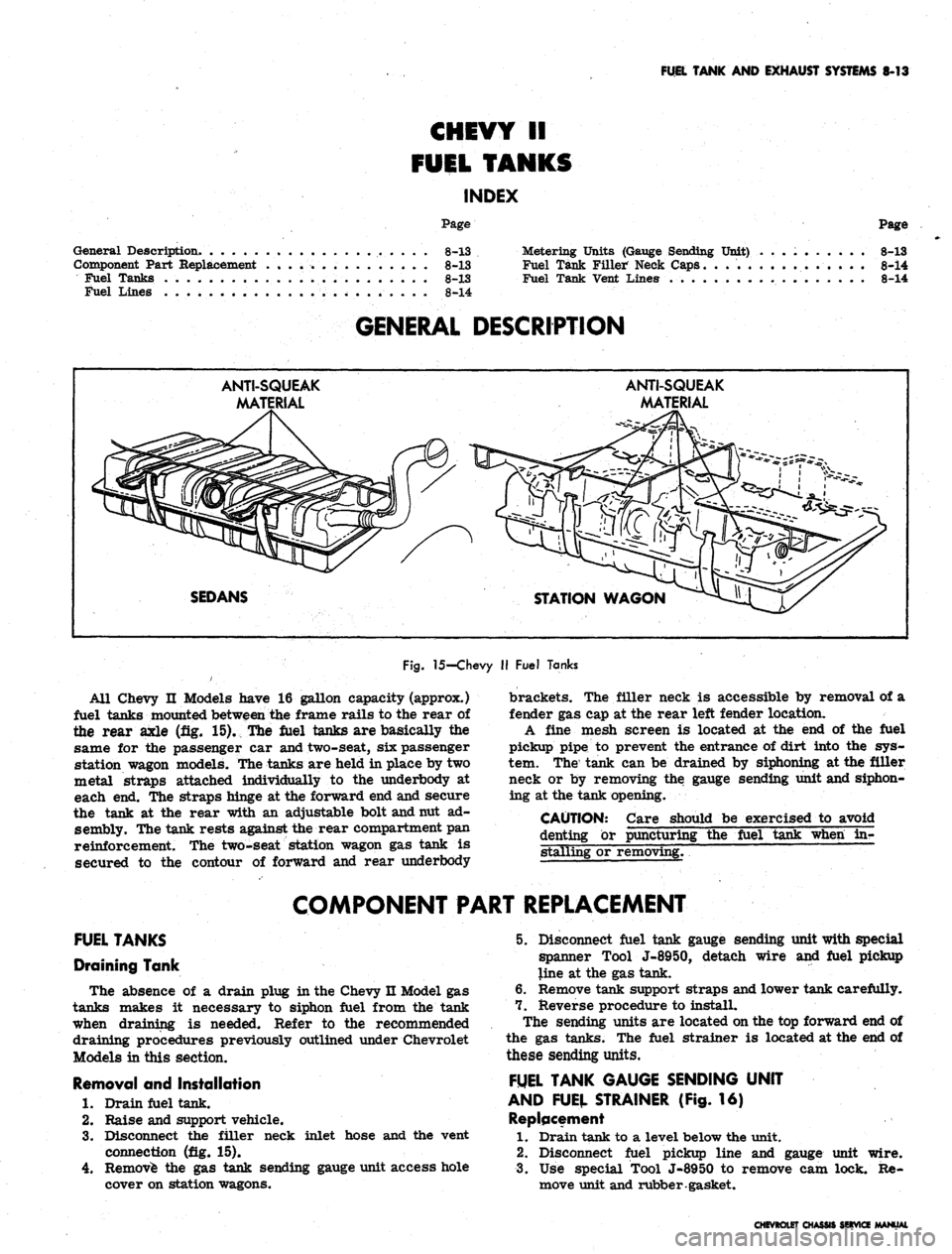
FUEL TANK
AND
EXHAUST SYSTEMS
8-13
CHEVY II
FUEL TANKS
INDEX
Page
Page
General Description.
8-13
Component Part Replacement
8-13
Fuel Tanks
8-13
Fuel Lines
8-14
Metering Units (Gauge Sending Unit)
8-13
Fuel Tank Filler- Neck Caps.
. . 8-14
Fuel Tank Vent Lines .......
8-14
GENERAL DESCRIPTION
ANTI-SQUEAK
MA'
ANTI-SQUEAK
MATERIAL
SEDANS
STATION WAGON
Fig.
15-Chevy
II
Fuel Tanks
All Chevy
II
Models have
16
gallon capacity (approx.)
fuel tanks mounted between
the
frame rails
to the
rear
of
the rear axle
(fig. 15). The
fuel tanks
are
basically
the
same
for the
passenger
car
and two-seat,
six
passenger
station wagon models. The tanks
are
held
in
place
by two
metal straps attached individually
to the
underbody
at
each
end. The
straps hinge
at the
forward
end
and secure
the tank
at the
rear with
an
adjustable bolt and nut
ad-
sembly. The tank rests against the rear compartment
pan
reinforcement.
The
two-seat station wagon
gas
tank
is
secured
to the
contour
of
forward
and
rear underbody
brackets.
The
filler neck
is
accessible
by
removal
of a
fender
gas cap at the
rear left fender location.
A fine mesh screen
is
located
at the end of the
fuel
pickup pipe
to
prevent
the
entrance
of
dirt into
the sys-
tem.
The
tank
can be
drained
by
siphoning
at the
filler
neck
or by
removing
the
gauge sending unit and siphon-
ing
at the
tank opening.
CAUTION: Care should
be
exercised
to
avoid
denting
or
puncturing
the
fuel tank when
in-
stalling
or
removing.
~
COMPONENT PART REPLACEMENT
FUEL TANKS
Draining Tank
The absence
of a
drain plug
in
the Chevy
n
Model
gas
tanks makes
it
necessary
to
siphon fuel from
the
tank
when draining
is
needed. Refer
to the
recommended
draining procedures previously outlined under Chevrolet
Models
in
this section.
Removal
and
Installation
1.
Drain fuel tank.
2.
Raise
and
support vehicle.
3.
Disconnect
the
filler neck inlet hose
and the
vent
connection
(fig. 15).
4.
Remove
the gas
tank sending gauge unit access hole
cover
on
station wagons.
5. Disconnect fuel tank gauge sending unit with special
spanner Tool J-8950, detach wire
and
fuel pickup
line
at the gas
tank.
6. Remove tank support straps and lower tank carefully.
7. Reverse procedure
to
install.
The sending units
are
located on
the top
forward
end of
the
gas
tanks.
The
fuel strainer
is
located
at the end of
these sending units.
FUEL TANK GAUGE SENDING UNIT
AND FUEL STRAINER
(Fig. 16)
Replacement
1.
Drain tank
to a
level below
the
unit.
2.
Disconnect fuel pickup line
and
gauge unit wire.
3.
Use
special Tool J-8950
to
remove
cam
lock.
Re-
move unit and rubber gasket.
CHEVROLET CHASSIS SERVICE MANUAL
Page 420 of 659
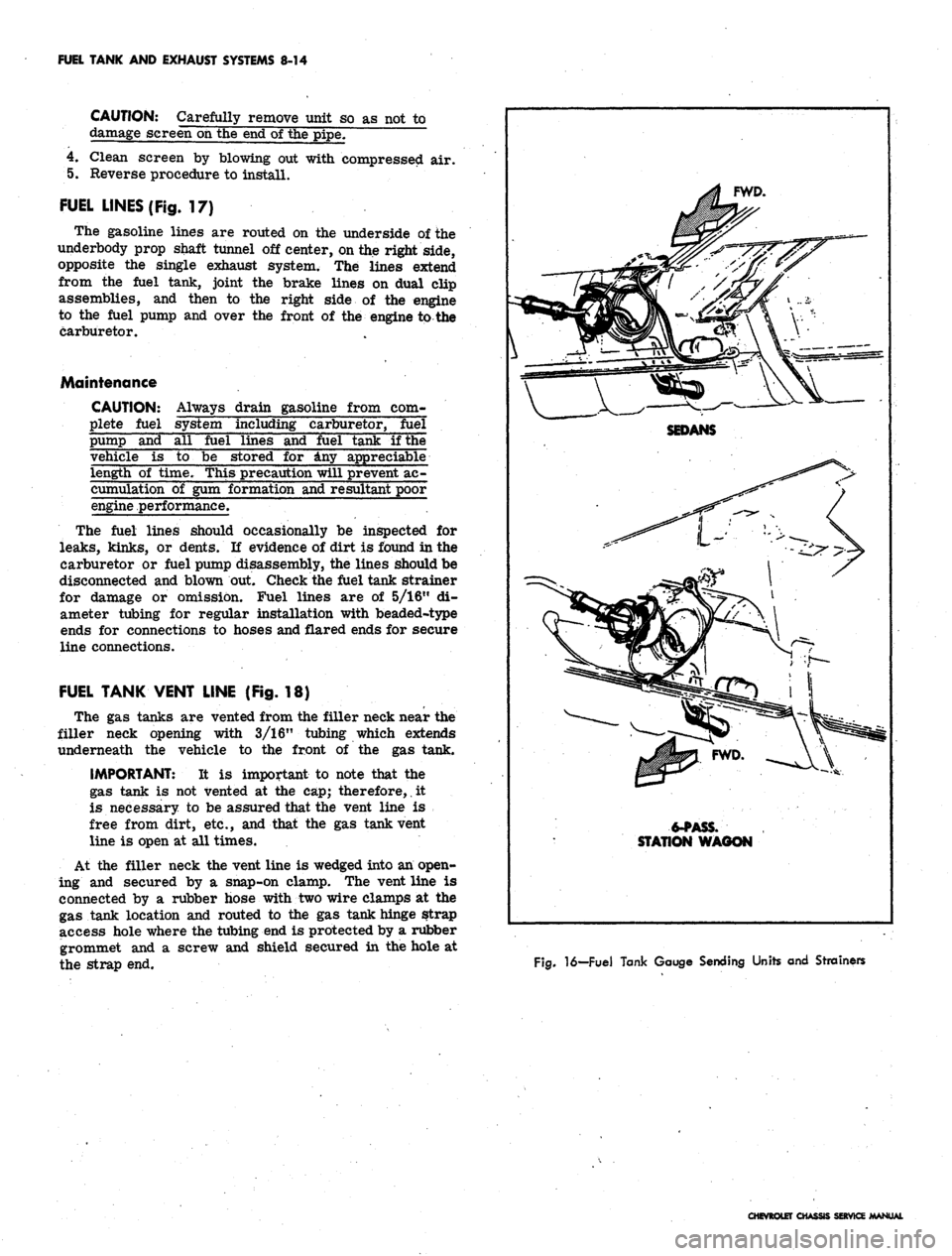
FUEL TANK AND EXHAUST SYSTEMS 8-14
CAUTION: Carefully remove unit so as not to
damage screen oh the end of the pipe,
4.
Clean screen by blowing out with compressed air.
5. Reverse procedure to install.
FUEL LINES (Fig. 17)
The gasoline lines are routed on the underside of the
underbody prop shaft tunnel off center, on the right side,
opposite the single exhaust system. The lines extend
from the fuel tank, joint the brake lines on dual clip
assemblies, and then to the right side of the engine
to the fuel pump and over the front of the engine to the
carburetor.
Maintenance
CAUTION:
plete fuel
Always drain gasoline from com-
system including carburetor, fuel
pump and all fuel lines and fuel tank if the
vehicle is to be stored for any appreciable
length of time. This precaution will prevent ac-
cumulation of gum formation and resultant poor
engine performance.
The fuel lines should occasionally be inspected for
leaks,
kinks, or dents. If evidence of dirt is found in the
carburetor or fuel pump disassembly, the lines should be
disconnected and blown out. Check the fuel tank strainer
for damage or omission. Fuel lines are of 5/16" di-
ameter tubing for regular installation with beaded-type
ends for connections to hoses and flared ends for secure
line connections.
FUEL TANK VENT LINE (Fig. 18)
The
gas
tanks
are
vented from
the
filler neck near
the
filler neck opening with
3/16"
tubing which extends
underneath
the
vehicle
to the
front
of the gas
tank.
IMPORTANT:
It is
important
to
note that
the
gas tank
is not
vented
at the cap;
therefore,
it
is necessary
to be
assured that
the
vent line
is
free from dirt,
etc., and
that
the gas
tank vent
line
is
open
at all
times.
At
the
filler neck
the
vent line
is
wedged into
an
open-
ing
and
secured
by a
snap-on clamp.
The
vent line
is
connected
by a
rubber hose with
two
wire clamps
at the
gas tank location
and
routed
to the gas
tank hinge strap
access hole where
the
tubing
end is
protected
by a
rubber
grommet
and a
screw
and
shield secured
in the
hole
at
the strap
end.
FWD.
SEDANS
6-PASS.
STATION WAGON
Fig. 16—Fuel Tank Gauge Sending Units and Strainers
CHEVROLET CHASSIS SERVICE MANUAL
Page 422 of 659
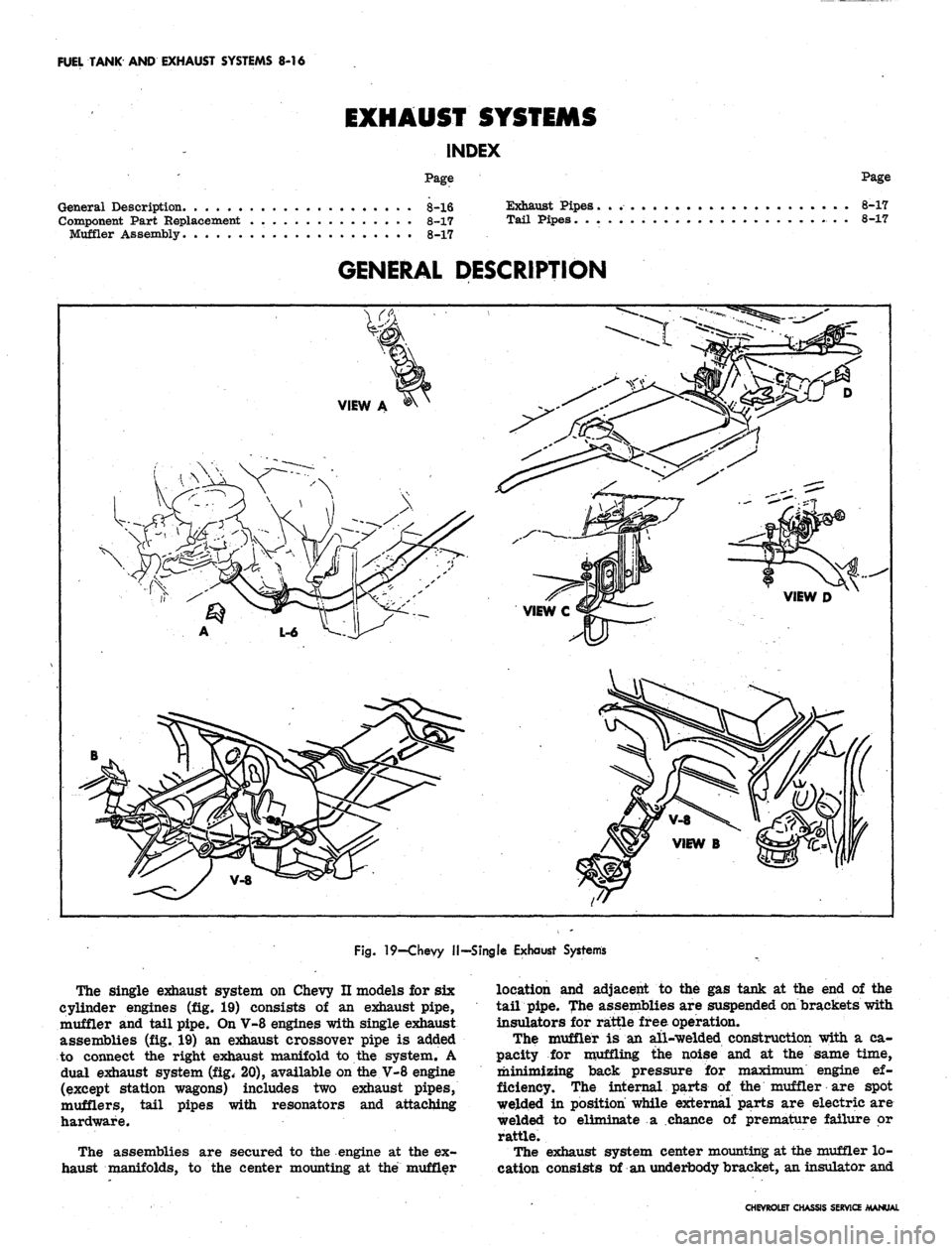
FUEL TANK AND EXHAUST SYSTEMS 8-16
EXHAUST SYSTEMS
INDEX
Page
General Description 8-16 Exhaust Pipes.
Component Part Replacement . 8-17 Tail Pipes. . .
Muffler Assembly 8-17
Page
8-17
8-17
GENERAL DESCRIPTION
Fig.
19-Cheyy If—Single Exhaust Systems
The single exhaust system on Chevy II models for six
cylinder engines (fig. 19) consists of an exhaust pipe,
muffler and tail pipe. On V-8 engines with single exhaust
assemblies (fig. 19) an exhaust crossover pipe is added
to connect the right exhaust manifold to the system. A
dual exhaust system (fig. 20), available on the V-8 engine
(except station wagons) includes two exhaust pipes,
mufflers, tail pipes with resonators and attaching
hardware.
The assemblies are secured to the engine at the ex-
haust manifolds, to the center mounting at the muffler
location and adjacent to the gas tank at the end of the
tail pipe. The assemblies are suspended on brackets with
insulators for rattle free operation.
The muffler is an all-welded construction with a ca-
pacity for muffling the noise and at the same time,
minimizing back pressure for maximum engine ef-
ficiency. The internal parts of the muffler are spot
welded in position while external parts are electric are
welded to eliminate a chance of premature failure or
rattle.
The exhaust system center mounting at the muffler lo-
cation consists of an underbody bracket, an insulator and
CHEVROLET CHASSIS SERVICE MANUAL
Page 423 of 659
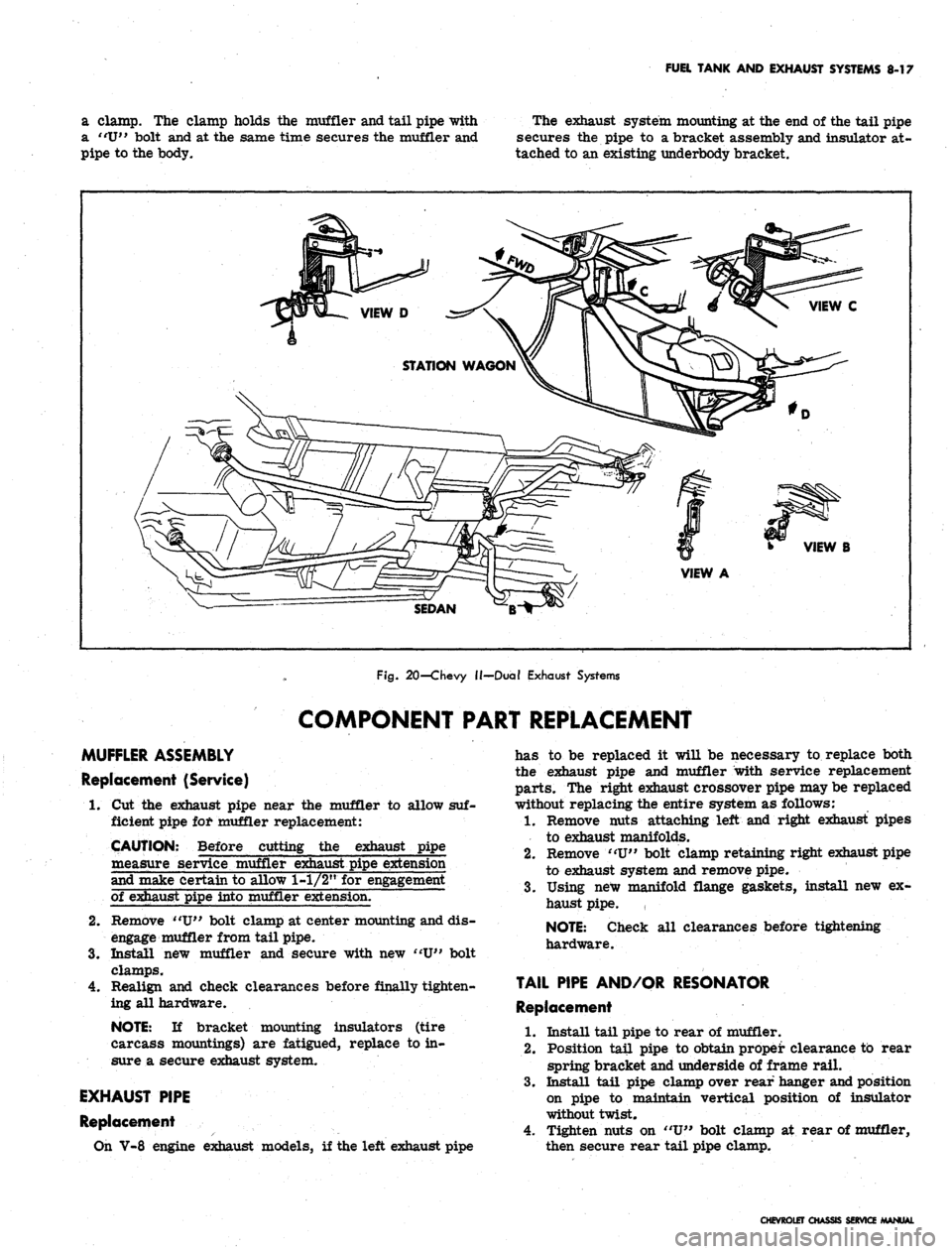
FUEL TANK AND EXHAUST SYSTEMS 8-17
a clamp. The clamp holds the muffler and tail pipe with
a "U" bolt and at the same time secures the muffler and
pipe to the body.
The exhaust system mounting at the end of the tail pipe
secures the pipe to a bracket assembly and insulator at-
tached to an existing underbody bracket.
VIEW B
VIEW A
Fig.
20—Chevy II—Dual Exhaust Systems
COMPONENT PART REPLACEMENT
MUFFLER ASSEMBLY
Replacement (Service)
1.
Cut the exhaust pipe near the muffler to allow suf-
ficient pipe for muffler replacement:
CAUTION: Before cutting the exhaust pipe
measure service muffler exhaust pipe extension
and make certain to allow 1-1/2" for engagement
of exhaust pipe into muffler extension.
2.
Remove "U" bolt clamp at center mounting and dis-
engage muffler from tail pipe.
3.
Install new muffler and secure with new "U" bolt
clamps.
4.
Realign and check clearances before finally tighten-
ing all hardware.
NOTE:
If bracket mounting insulators (tire
carcass mountings) are fatigued, replace to in-
sure a secure exhaust system.
EXHAUST PIPE
Replacement
On V-8 engine exhaust models, if the left exhaust pipe
has to be replaced it will be necessary to replace both
the exhaust pipe and muffler with service replacement
parts.
The right exhaust crossover pipe may be replaced
without replacing the entire system as follows:
1.
Remove nuts attaching left and right exhaust pipes
to exhaust manifolds.
2.
Remove "U" bolt clamp retaining right exhaust pipe
to exhaust system and remove pipe.
3.
Using new manifold flange gaskets, install new ex-
haust pipe.
NOTE:
Check all clearances before tightening
hardware.
TAIL PIPE AND/OR RESONATOR
Replacement
1.
Install tail pipe to rear of muffler.
2.
Position tail pipe to obtain proper clearance to rear
spring bracket and underside of frame rail.
3.
Install tail pipe clamp over rear hanger and position
on pipe to maintain vertical position of insulator
without twist.
4.
Tighten nuts on "U" bolt clamp at rear of muffler,
then secure rear tail pipe damp.
CHEVROLET CHASSIS SERVICE MANUAL
Page 424 of 659

FUEL TANK
AND
EXHAUST SYSTEMS
8-18
CORVETTE
FUEL TANK
INDEX
Page
General Description.
. 8-18
Service Operations
8-18
Fuel Tank
8-18
Gauge Sending Unit
8-20
Fuel Lines.
8-20
GENERAL DESCRIPTION
20 GALLON TANK
Fig.
21
—Corvette Fuel Tanks
The Corvette
is
equipped with
a
standard
20
gallon
(approx.) tank
or an RPO 36
gallon (approx.) fiberglass
tank
(fig. 21). The
tanks
are
installed
at the
very rear
of
the
vehicle, convenient
for
direct fuel filling into
the
tank.
The
tanks
are
held
in
place
by
two metal straps
at-
tached individually
to a
removable
gas
tank frame
sup-
port.
Two
guides
at the end of
the straps
are
adjustable
for securing
the
straps onto
the
tank support. The tank
support
is
secured
to the
frame rail with flat washers,
lockwashers, bolts
and
nuts.
The
tanks' rest
on six
felt
anti-squeak pads.
One pad
centers
on the
rear frame
crossmember
and one at
each side
on the
same cross-
member.
At the
same rear location two pads
are
placed
on
the
tank
at the
metal support strap (rear) attachment
location
and
another anti-squeak
pad
cemented
on the
support
at
the front
of
the tank.
The fuel tanks
are
equipped with
a gas
gauge metering
unit,
a
fuel pickup, fuel strainer
and
vent line.
If it be-
comes necessary,
the
tank
can be
completely drained
by
removing
the
fuel pickup hose which
is
located
at
the
bot-
tom
of the
tank,
or
by removing the metering
for
quicker
draining.
A pressure vacuum type, positive vented design
cap,
conforming
to
I.C.C. regulations,
is
used on both regular
production
and
optional fuel tanks.
The cap is
inter-
changeable with past model tanks
for
service replace-
ment purposes.
SERVICE OPERATIONS
FUEL TANK
CAUTION:
IF THE GAS
TANK SHOULD
BE
REMOVED
AND
INSTALLED, CARE SHOULD
BE EXERCISED
TO
AVOID PUNCTURING,
DROPPING
OR
DENTING
THE GAS
TANK.
Removal
(20
Gallon Tank)
WARNING: FIRST REMOVE BATTERY
CABLE.
1.
Remove
the
spare tire from tire carrier.
2.
Remove spare tire carrier bolted attachments
and
carrier
(fig. 22).
3.
Remove
the "U"
bolt attachments
at
both rear tail
pipe
(See
Figure
23).
4.
Separate
the
exhaust system
at
the transmission sup-
port crossmember
by
loosening
the "U"
bolt nuts.
5. Remove both rear muffler brackets from
the
frame
and slide
the
muffler system rearward.
CHEVROLET CHASSIS SERVICE MANUAL
Page 426 of 659

FUEL TANK AND EXHAUST SYSTEMS 8-20
4.
Attach the retaining straps with strap guide attached
to the fuel tank support, and secure with-the nut and
lockwasher assembly.
5. Connect the filler neck boot to the drain hose of the
tank and install boot around filler neck,
6. Connect the fuel pickup line, ground wire and make
certain that the fuel drain line is flush to 1/2" in-
board of the rear bumper opening.
7. Attach tank metering unit wires (fig. 25).
8. Replace fuel in tank. Replace gas cap.
9. Check for possible leaks.
10.
Reconnect the exhaust system by reversing the above
removal procedures (see "Exhaust System").
11.
Install spare tire carrier by securing the bolt
attachment.
12.
Install the spare tire in the tire carrier.
Removal (36 Gallon Tank)
1.
Remove cover (fig. 26).
2.
Disconnect hoses and drain tank and remove two
fittings at bottom of tank.
3.
Disconnect fuel and vent lines and wires at tank
(fig. 27).
4.
Remove straps.
installation (36 Gallon Tank)
Reverse removal procedure to install.
FUEL TANK METERING UNIT OR GAUGE
SENDING UNIT AND STRAINER
The fuel tank metering unit is located at the bottom of
the fuel tank. The fuel strainer is attached at the end of
the sending unit inside the tank.
Replacement (20 Gallon Tank)
1.
Follow fuel tank removal procedure through Step 2.
2.
Drain the tank. Disconnect the attaching wires.
3.
Remove metering unit with a fuel tank gauge unit
Spanner J-8950 (revised).
4.
'Remove metering unit and gasket.
CAUTION: Carefully remove unit so as not to
damage screen on the end of the pipe.
5. Clean strainer screen by blowing out with com-
pressed air.
6. Reverse procedure to install.
Replacement (36 Gallon Tank)
1.
Remove cover.
2.
Follow Steps 2 thru 6 as outlined under replacement
for 20 gallon tank.
FUEL LINES
20 Gallon Tank
The fuel lines are conveniently located along the out-
side of the right frame rail (fig. 28). The lines extend
Fig.
26—Gasoline Tank (36 Gallon) Compartment Cover
from the fuel tank pickup at the bottom of the tank, along
the rear frame crossmember to the right frame rail,
extending through the rail at the kickup area and along the
top inside edge of the frame to the fuel pump, Flexible
hoses are located at the fuel tank pickup and at the fuel
pump.
36 Gallon Tank
The 36 gallon tank fuel lines are routed from the bot-
tom of both sides of the tank to the right frame rail
(fig. 20).
Maintenance
CAUTION: Always drain gasoline from the
complete fuel system including carburetor, fuel
pump and all fuel lines and fuel tank if the vehi-
cle is to be stored for any great length of time.
This precaution will prevent accumulation~ol
gum formation and resultant poor engine
performance.
. The fuel lines should occasionally be inspected for
leaks,
kinks or dents, especially when work has been
done on the underside of car or after the car has been
traveling over rough or stone roads at higher speeds.
If evidence of dirt is found in the carburetor or fuel pump
at disassembly, the lines should be disconnected and
blown put. Check the fuel tank strainer for damage or
omission.
Fuel lines are beaded-type ends for connection to
hoses and flared ends for secure metal-to-metal line
connections.
CHEVROLET CHASSIS SERVICE MANUAL
Page 431 of 659
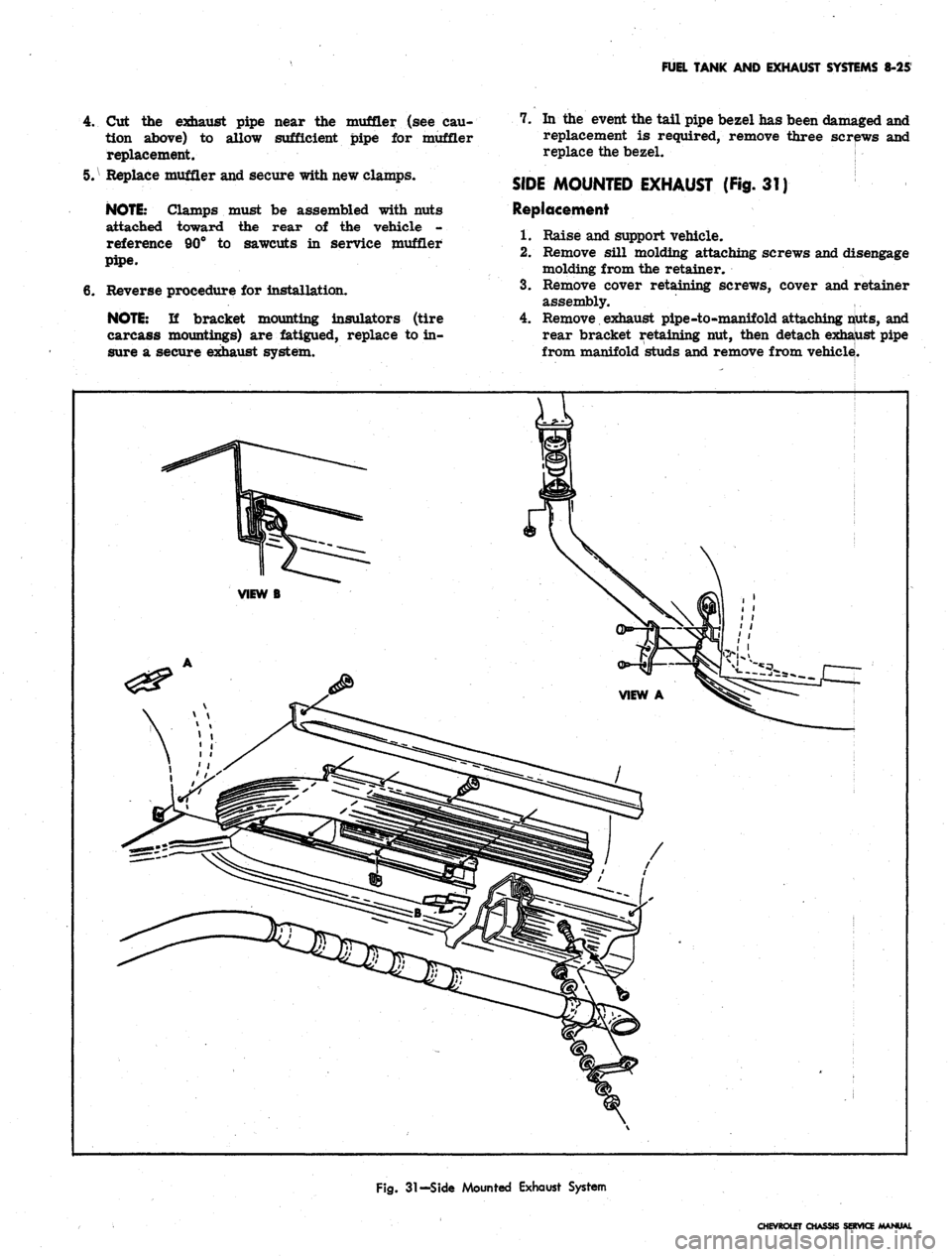
FUEL TANK AND EXHAUST SYSTEMS 8-25
4.
Cut the exhaust pipe near the muffler (see cau-
tion above) to allow sufficient pipe for muffler
replacement.
5.
^
Replace muffler and secure with new clamps.
NOTE:
Clamps must be assembled with nuts
attached toward the rear of the vehicle -
reference 90° to sawcuts in service muffler
pipe.
6. Reverse procedure for installation.
NOTE:
If bracket mounting insulators (tire
carcass mountings) are fatigued, replace to in-
sure a secure exhaust system.
7. In the event the tail pipe bezel has been damaged and
replacement is required, remove three screws and
replace the bezel. i
SIDE MOUNTED EXHAUST (Fig. 31)
Replacement
1.
Raise and support vehicle.
2.
Remove sill molding attaching screws and disengage
molding from the retainer.
3.
Remove cover retaining screws, cover and retainer
assembly.
4.
Remove exhaust pipe-to-manifold attaching nuts, and
rear bracket retaining nut, then detach exhaust pipe
from manifold studs and remove from vehicle.
Fig.
31—Side Mounted Exhaust System
CHEVROLET
CHASSIS SEKVK